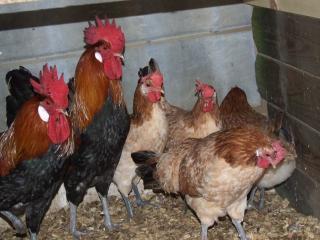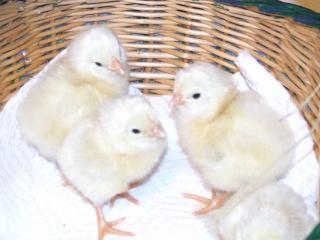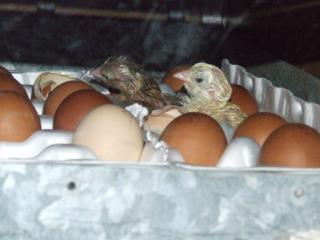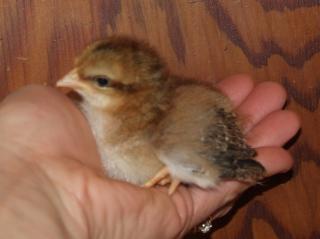i got wheton, and split wheton/black penedesenca chicks growing right now, and i will be getting more black eggs from ON next year (along with other eggs... I hope) i will be hatching/selling penedesenca chicks next spring, my new incubator does not help the penedesenca addiction
Navigation
Install the app
How to install the app on iOS
Follow along with the video below to see how to install our site as a web app on your home screen.
Note: This feature may not be available in some browsers.
More options
You are using an out of date browser. It may not display this or other websites correctly.
You should upgrade or use an alternative browser.
You should upgrade or use an alternative browser.
Dark Egg Breeds Thread
- Thread starter drom
- Start date
Just thought that I would share a photo of some of my Welsummer eggs. Wish I could share some Barnevelder egg photos but they are not laying yet.
Thanks for starting a thread on dark egg genetics Drom! This will be a great discussion.
Welsummer Eggs

Thanks for starting a thread on dark egg genetics Drom! This will be a great discussion.
Welsummer Eggs

there is a reason is because b davis is to far south and alagator mixed in with birds as we all know gator sex is because of temp in ground for male or female geesh i gotta educate all u chicken pros on genettics
.....
Quote:
Well, Kathy shouldn't feel bad my bigger, rounder eggs ended up being Wheatens..... AND they were roosters also.

That sounds like a fun experiment though Geebs.
Oh and I think B. Davis said on her thread that when she had a problem with the temp in her incubator being (I think) too high, she got a higher ratio of cockerels, which I guess would suggest that the little pullets are just more fragile
.....
Quote:
Well, Kathy shouldn't feel bad my bigger, rounder eggs ended up being Wheatens..... AND they were roosters also.

That sounds like a fun experiment though Geebs.
Oh and I think B. Davis said on her thread that when she had a problem with the temp in her incubator being (I think) too high, she got a higher ratio of cockerels, which I guess would suggest that the little pullets are just more fragile
That was a great idea pinkchick to use the clay pot to help show true color. Nice eggs by the way.
I am thrilled we have this new thread. I don't have any Wellies, Barnies, or Pendies either but would love to learn more and see everyone elses.
geebs I am really looking forward to the results of your experiment!
I am thrilled we have this new thread. I don't have any Wellies, Barnies, or Pendies either but would love to learn more and see everyone elses.
geebs I am really looking forward to the results of your experiment!
Thanks Germaine! Wellies are tons of fun! I love them as much as Marans. I can't wait for my Barnies to start laying, they came from nicely colored coppery tinted eggs. Most of the Barnie eggs I hatched out were identical to a Welsummer egg. I am addicted to dark egg layers. I have no interest in Pene's but they are lovely birds but I believe they may be to flighty for my taste. I am having fun crossing different breeds to the dark egg laying breeds that I have, in fact I have so many dark layer crosses that I only have 2 light colored egg layers left in the laying flock, but I did accidentally get talked into bringing home the last 4 lonely black sexlinks from the feed store earlier this year, so I will be getting a few tan eggs. lol!
Oh... almost forgot to mention that the Barnevelders I have are just as sweet tempered as my Wellies and Marans, I have one little cockerel "Ugh" who is going to be totally co-dependant on humans, I can tell already.

Oh... almost forgot to mention that the Barnevelders I have are just as sweet tempered as my Wellies and Marans, I have one little cockerel "Ugh" who is going to be totally co-dependant on humans, I can tell already.

This may or may not pertain to chickens but I thought that I would post it anyway and maybe a genetics expert will come by and give us their interpretation of it and if it holds any merit by way of chicken egg color. I found this article a couple of years ago and saved it because I thought it was interesting. Borrowed from Wikipedia.
"The default color of vertebrate eggs is the white of the calcium carbonate from which the shells are made, but some birds, mainly passerines, produce colored eggs. The pigments biliverdin and its zinc chelate give a green or blue ground color, and protoporphyrin produces reds and browns as a ground color or as spotting.
Non-passerines typically have white eggs, except in some ground-nesting groups such as the Charadriiformes, sandgrouse and nightjars, where camouflage is necessary, and some parasitic cuckoos which have to match the passerine host's egg. Most passerines, in contrast, lay colored eggs, even if there is no need of cryptic colors.
However, a recent study suggests that the protoporphyrin markings on passerine eggs actually act to reduce brittleness by acting as a solid state lubricant. If there is insufficient calcium available in the local soil, the egg shell may be thin, especially in a circle around the broad end. Protoporphyrin speckling compensates for this, and increases inversely to the amount of calcium in the soil.
For the same reason, later eggs in a clutch are more spotted than early ones as the female's store of calcium is depleted.
The color of individual eggs is also genetically influenced, and appears to be inherited through the mother only, suggesting that the gene responsible for pigmentation is on the sex determining W chromosome (female birds are WZ, males ZZ).
It used to be thought that color was applied to the shell immediately before laying, but this research shows that coloration is an integral part of the development of the shell, with the same protein responsible for depositing calcium carbonate, or protoporphyrins when there is a lack of that mineral.
In species such as the Common Guillemot, which nest in large groups, each female's eggs have very different markings, making it easier for females to identify their own eggs on the crowded cliff ledges on which they breed."
http://en.wikipedia.org/wiki/Egg_(biolog
"The default color of vertebrate eggs is the white of the calcium carbonate from which the shells are made, but some birds, mainly passerines, produce colored eggs. The pigments biliverdin and its zinc chelate give a green or blue ground color, and protoporphyrin produces reds and browns as a ground color or as spotting.
Non-passerines typically have white eggs, except in some ground-nesting groups such as the Charadriiformes, sandgrouse and nightjars, where camouflage is necessary, and some parasitic cuckoos which have to match the passerine host's egg. Most passerines, in contrast, lay colored eggs, even if there is no need of cryptic colors.
However, a recent study suggests that the protoporphyrin markings on passerine eggs actually act to reduce brittleness by acting as a solid state lubricant. If there is insufficient calcium available in the local soil, the egg shell may be thin, especially in a circle around the broad end. Protoporphyrin speckling compensates for this, and increases inversely to the amount of calcium in the soil.
For the same reason, later eggs in a clutch are more spotted than early ones as the female's store of calcium is depleted.
The color of individual eggs is also genetically influenced, and appears to be inherited through the mother only, suggesting that the gene responsible for pigmentation is on the sex determining W chromosome (female birds are WZ, males ZZ).
It used to be thought that color was applied to the shell immediately before laying, but this research shows that coloration is an integral part of the development of the shell, with the same protein responsible for depositing calcium carbonate, or protoporphyrins when there is a lack of that mineral.
In species such as the Common Guillemot, which nest in large groups, each female's eggs have very different markings, making it easier for females to identify their own eggs on the crowded cliff ledges on which they breed."
http://en.wikipedia.org/wiki/Egg_(biolog
Last edited:
Here are some of my dark egg layer kids.
Wheaten Penedesenca breeders

Wheaten Penedesenca chicks

Wheaten & Partridge Penedesenca chicks hatching (light egg is a cochin)
I sold my Partridge flock to a friend a few months ago, so I could focus on the Wheatens
 I hope to have at least 10-15 hens laying in the Spring.
I hope to have at least 10-15 hens laying in the Spring.

Black Copper Marans

BCM chick

Marans eggs (5 months into laying cycle)

Welsummer roo

Wellie chick

I'll add Wellie eggs later
Wheaten Penedesenca breeders

Wheaten Penedesenca chicks

Wheaten & Partridge Penedesenca chicks hatching (light egg is a cochin)
I sold my Partridge flock to a friend a few months ago, so I could focus on the Wheatens


Black Copper Marans

BCM chick

Marans eggs (5 months into laying cycle)

Welsummer roo

Wellie chick

I'll add Wellie eggs later
Last edited:
The color of individual eggs is also genetically influenced, and appears to be inherited through the mother only, suggesting that the gene responsible for pigmentation is on the sex determining W chromosome (female birds are WZ, males ZZ).
Great info PinkChick! I was under the impression that the dark egg gene in BCM's came from the Roo. Is that incorrect.
Keep the other dark egg layer pics coming everybody. I love learning about them.
Oh and Pink Chick I just read on someones post this last week about how sweet Barnevelders are! Nice birds are always welcome!
Great info PinkChick! I was under the impression that the dark egg gene in BCM's came from the Roo. Is that incorrect.
Keep the other dark egg layer pics coming everybody. I love learning about them.
Oh and Pink Chick I just read on someones post this last week about how sweet Barnevelders are! Nice birds are always welcome!
Rusty~
I was under the same impression as you about the BCM thing, as I said previously, I don't know if that write up has anything to do with chicken genetics specifically, just found it very interesting and since chickens are "birds" I would think that something in there must apply....somewhere....somehow, yeah/no??? lol!
Debbi~
I don't know.

This was the info in that article that intrigued me the most and I can't stop thinking about how it may/could apply more specifically to the Marans eggs.
I was under the same impression as you about the BCM thing, as I said previously, I don't know if that write up has anything to do with chicken genetics specifically, just found it very interesting and since chickens are "birds" I would think that something in there must apply....somewhere....somehow, yeah/no??? lol!
Debbi~
I don't know.

This was the info in that article that intrigued me the most and I can't stop thinking about how it may/could apply more specifically to the Marans eggs.
and protoporphyrin produces reds and browns as a ground color or as spotting.
However, a recent study suggests that the protoporphyrin markings on passerine eggs actually act to reduce brittleness by acting as a solid state lubricant. If there is insufficient calcium available in the local soil, the egg shell may be thin, especially in a circle around the broad end. Protoporphyrin speckling compensates for this, and increases inversely to the amount of calcium in the soil.
For the same reason, later eggs in a clutch are more spotted than early ones as the female's store of calcium is depleted.
For the same reason, later eggs in a clutch are more spotted than early ones as the female's store of calcium is depleted.
Last edited:
New posts New threads Active threads
-
Latest posts
-
-
-
-
Gypsy went broody- Junglefowl in mom mode in a empty nest
- Latest: CabritaChicks
-
-
-
Latest threads
-
Wilcox Farm egg yolks - how do they do it?
- Started by mermaid_of_the_farm
- Replies: 1
-
-
Winter prep for chicken run
- Started by Everythingistaken
- Replies: 0
-
-
Ventilation questions! Help me design this coop please!
- Started by Limepink
- Replies: 1
-
-
Threads with more replies in the last 15 days
-
-
I culled my first cockerel, now what?
- Started by redinator
- Replies: 120
-
*Answer These Questions The Best You Can Please *
- Started by N3mesis_IceWing_NightWing
- Replies: 107
-
-
-
×

